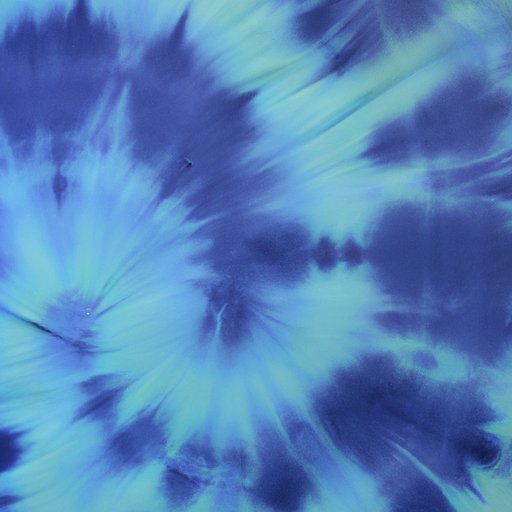
I. Introduction
Have you ever tried tie-dyeing fabric with bleach? It’s a unique twist on the classic technique that can create a range of artistic patterns and designs. This article is a step-by-step guide to tie-dying fabric with bleach, including creative designs and tips for achieving different effects.
II. Step-by-Step Guide to Tie-Dying Fabric with Bleach
To tie-dye with bleach, you’ll need the following materials:
- Cotton fabric
- Bleach
- Water
- Rubber bands or string
- Spray bottle
Here are the steps to follow:
1. Preparation of fabric
Before diving into the process, it is important to prepare the fabric. Wash it to remove any dirt or chemicals that may impede the process. Cut the fabric into squares, rectangles, or any preferred shape and size.
2. Folding and tying fabric
To create a design, fold the fabric as desired. You can achieve a spiral pattern by pinching a section of the fabric at the center and twisting it. Then use rubber bands or string to tie it tightly. Alternatively, create a heart-shaped design by folding the fabric in half and cutting out half of a heart shape along the crease. Subsequently, alternate ties on every cut edge. There are numerous patterns to explore, and you can also create your own.
3. Applying bleach mixture
Now it’s time to create the bleach mixture. Mix 1 part of bleach with two parts of water in a spray bottle. Spray the bleach mixture on the fabric, creating the desired effect and saturation. Keep spraying until the color turns into the desired shade. For lighter colors, spray at lower saturations or dilute the bleach mixture.
Tips for creating different patterns and effects
Experiment with different combinations of folds and ties to create unique patterns. For example, try a splatter pattern by scrunching the fabric and randomly spraying bleach directly onto it. You can experiment with different folds, twists, and crumpling techniques that will create unique patterns and designs.
III. Five Creative Tie-Dye Designs to Try with Bleach
Here are five unique tie-dye designs to try with bleach:
1. Ombre Effect
To achieve an ombre effect, fold the fabric in half lengthwise and submerge half of it in the bleach mixture for a few minutes. Gradually pull the fabric out of the mixture, allowing the bleach to create an ombre effect from the darkest to the lightest shade.
2. Checkerboard Pattern
Create this pattern by folding the fabric in a checkerboard pattern and tying it with rubber bands. Spray the bleach mixture on the untied squares for a checkerboard pattern.
3. Star Pattern
To create this design, fold the fabric in half diagonally and fold it many times. Cut out a star shape and tie the fabric where you would like the star to be. Spray the bleach mixture on the exposed fabric.
4. Striped Pattern
Fold the fabric into pleats and tie it with rubber bands. Spray the bleach mixture on the fabric in the areas between the rubber bands.
5. Polka Dot Pattern
Create polka dots by using a circle-shaped object (like a lid) and tracing it onto the fabric. Tie the sections with rubberbands, and then spray the bleach mixture on the exposed areas.
IV. Comparison Between Traditional Tie-Dye Methods and Using Bleach
Traditional tie-dye methods involve using colored dyes to create designs on fabric, while tie-dyeing with bleach uses the bleaching effect of chlorine to alter the color of the fabric. Bleach creates a unique effect by removing color from the fabric, while traditional tie-dye methods add color. The benefits of using bleach tie-dyeing are that it is quick, easy, and can create unique effects that are difficult to achieve with traditional tie-dye methods. On the other hand, traditional tie-dyeing methods allow for unlimited color options that bleach does not provide. Choose the method depending on the desired outcome and convenience.
V. The History of Tie-Dyeing and Its Modern Popularity
For centuries, cultures around the world have used tie-dyeing to decorate and personalize textiles. This technique’s dynamic nature and various design options have led to an ongoing resurgence of tie-dyeing in modern fashion and even home decor. Bleach-based tie-dyeing is becoming especially popular, as its unique results add bold and creative patterns to clothing and other accessories.
VI. Q&A with an Expert Tie-Dyer
We spoke with an expert tie-dyer for an insider’s perspective on tie-dyeing with bleach. Here are her top tips:
- Experiment with different fabric types. Cotton works best because it absorbs the bleach easily, but you can also try other materials such as silk or rayon for unique effects.
- Wear gloves to protect your hands from the bleach.
- Make sure to rinse the bleached fabric thoroughly in water to stop the bleaching process before washing it.
- Use a well-ventilated area or wear a mask when working with bleach to avoid inhaling the fumes.
VII. Conclusion
Overall, tie-dyeing with bleach is an innovative way to personalize fabric and create unique designs. With just a few simple steps and some creativity, you can use this method to make patterns and designs for all sorts of different textiles. Playing around with different folds, ties, and bleach concentrations can lead to even more unique results and designs.




